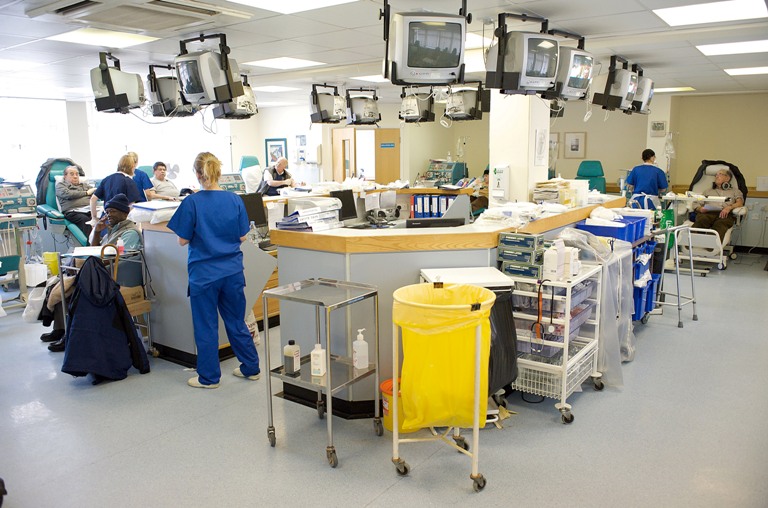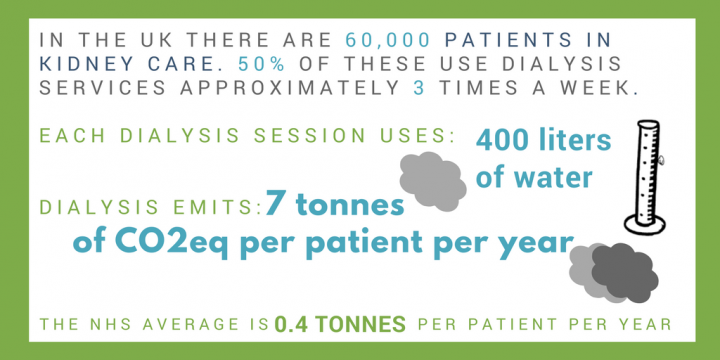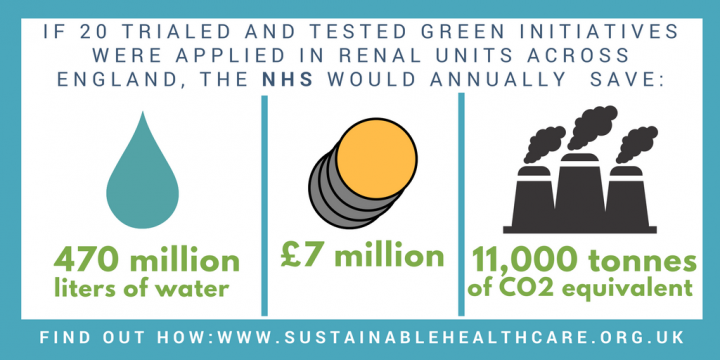
Sustainability Series: Snapshot of Kidney Care
Examining the environmental impact of kidney care.

Kidney care is a key carbon emitter
In 2015 NHS England emitted 22.8 million tonnes of CO2eq. Kidney care contributes significantly and disproportionately to this. The carbon cost of kidney care patients is 161 kg CO2eq per bed day, compared to the average 80 kg CO2eq per bed day of other secondary care patients (as estimated by the NHS Sustainable Development Unit) (1).
Kidney care has been described as a ‘high financial cost, low volume’ specialty, meaning that although not amongst the most common procedures, its financial costs are especially high. The same applies to its high environmental cost which arises from the procurement of complex medical equipment and pharmaceuticals as well as from being a high energy and water use care pathway.
One example procedure in kidney care is dialysis which is administered 3 times a week to approx. 50% of the UK’s 60,000 kidney care patients (2). A single dialysis session uses 400 litres of water (2/3rd of which is wasted) (3) and it has been calculated that 7.1 tonnes of CO2eq are emitted per year for each dialysis patient (1).

Saving money and carbon
Kidney care, like many parts of the NHS is severely stretched for money. Demand for healthcare services are increasing as more people live longer. At the same time there is a severe funding squeeze as the NHS budgets grow more slowly - budgets are set to grow by an average of 1.1% per year between 2010 and 2020, compared to the long term average of 4% per year (4).
Amongst severe funding shortages and increasing demands on the NHS, cutting carbon may seem like an unreasonable additional demand. However, done effectively, reducing carbon emissions can in fact significantly reduce both the financial and carbon costs of healthcare.
Through 10 years of research, numerous interventions and initiatives have been established that can alter clinical kidney care pathways to reduce the amount of waste and carbon they produce.
Researchers at CSH found that if 20 green nephrology initiatives were implemented in all kidney units in England, the NHS could save £7 million, as well as 470 million litres of water and 11,000 tonnes of CO2eq. (5)

CSH’s Green Nephrology programme addresses this clear need for change by establishing sustainability as an integral part of nephrology - changing service design, procurement, and practice, and thereby ultimately moving towards a cultural shift in how sustainability is regarded in kidney care. Over the last ten years we have:
- Established a fellowship programme and hosted two Green Nephrology fellows to advance knowledge of sustainability in kidney care
- Conducted research into measuring the environmental impacts of kidney care
- Identified and implemented routes to practical change. You can find out about where sustainable kidney care is happening here and find out more about specific sustainable nephrology interventions here (available next week).
- Created the Green Nephrology network to catalyse conversation and sustainable practice amongst healthcare professionals. 80% of UK renal units are now included on this map.
There are many ways in which kidney care can be made more sustainable. Some interventions which have been developed and successfully implemented by CSH are featured in our “How to Guide” post next week - make sure to take a look!
1) The Carbon Footprint of a Renal Service in the United Kingdom, Connor A, Lillywhite R, Cooke MW. Quarterly Journal of Medicine 2010 103 965 - 975.
2) UK Renal Registry: https://www.renalreg.org/reports/2016-nineteenth-annual-report/
3) Toward Green Dialysis: A Case Study to Illustrate and Encourage the Salvage of Reject Water Connor A. Milne S. Owen A. Boyle G. Mortimer F. Stevens PE. Journal of Renal Care 2010;36(2),68-72.
4) Kings Fund, 2017, Does the NHS need more money?
5) NHS could save £1bn by adopting green strategies used in kidney units. Limb M. British Medical Journal 2013;346:f588 doi: 10.1136/bmj.f588

